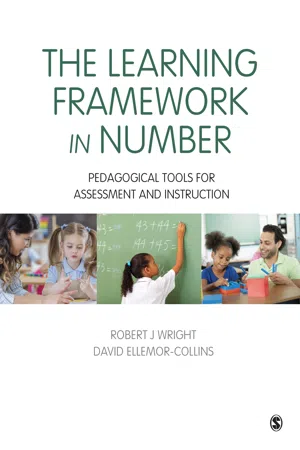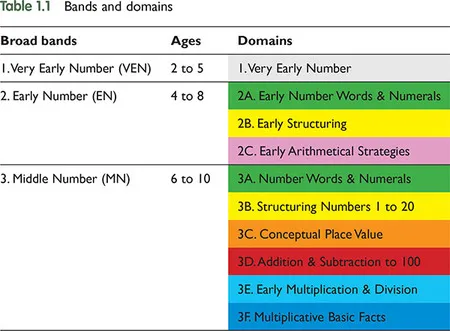The LFIN spans three broad bands of number learning. Table 1.1 sets out the three bands and indicative age ranges for each. Our main focus is on Band 2, Early Number (EN), and Band 3, Middle Number (MN).
Within Band 2 and Band 3, the LFIN identifies key domains of number learning. The table sets out these domains – three in Early Number and six in Middle Number. The domains have letter codes, 2A to 2C and 3A to 3F, and colour codes, which we use throughout the materials.
Domains
Our sense of these domains has developed over years of our research and teaching. Each domain is regarded as a substantial area of number learning. From the perspective of the teacher, each domain can be somewhat distinct from the other domains, involving distinctive assessment tasks and instructional procedures. Each is worth sustained instructional attention over many months, probably two to three years in the case of the larger domains (e.g. 3B, 3D and 3F). Acquiring sound knowledge of a domain is a significant accomplishment in mathematics learning.
There are, of course, important connections and overlaps between the domains. Instruction within each domain includes developing these connections to other domains.
Overview of each domain
Below is a brief description of each domain. More detailed accounts of each domain are developed in later chapters, through the descriptions of the assessment schedules, models and teaching charts in each domain.
1. Very Early Number
Our purpose in including Very Early Number as Band 1 is to highlight that typically, children acquire significant number knowledge prior to starting school. As well, there is significant very early number knowledge that is not included in the curriculum for students in the first year of school. Insights into this knowledge are provided by the work of developmental psychologists who have observed and documented the number knowledge typical of, for example, 2-, 3- and 4-year-olds.
2A. Early Number Words and Numerals
This domain involves knowledge of basic spoken number word sequences by ones, both forward and backward, such as ‘one, two, three, … twenty’ and ‘thirty-two, thirty-one, thirty, twenty-nine, twenty-eight’. The domain also involves reading and writing numerals. For both number words and numerals, the domain focuses on the range up to 100.
2B. Early Structuring
This domain involves knowledge of finger patterns for numbers up to 10, and standard spatial configurations, such as dice and domino patterns. The domain also involves knowledge of small combinations and partitions, such as small doubles (1&1, 2&2, 3&3, 4&4, 5&5), and five-pluses (5&1, 5&2, 5&3, 5&4, 5&5), and additional emerging knowledge of addition and subtraction in the range 1 to 10.
2C. Early Arithmetic Strategies
Early arithmetic strategies refers to a progression of counting-based strategies that children use to solve counting, additive and subtractive tasks, such as counting the items in a collection, determining the number of items in two collections, or the number of items remaining after some items are removed. These strategies arise in situations where the items to be counted are in the child’s visual field or are screened and thus unavailable to count perceptually. These strategies include the advanced counting-by-ones strategies, that is, counting-on and counting-back.
3A. Number Words and Numerals
This domain extends from Domain 2A, into the range to 1000 and beyond. The domain involves knowledge of number word sequences and numeral sequences, including sequences by 1s, 10s and 100s. This domain also involves reading and writing numerals, up to 5-digit numerals and further.
3B. Structuring Numbers 1 to 20
This domain involves number combinations and partitions in the range 1 to 20, and facility with mental strategies for addition and subtraction that do not involve counting-by-ones. The domain progresses from the finger patterns of Domain 2B, to the use of five-frames, ten-frames and the arithmetic rack, and increasingly to reasoning about bare numbers with independence from any such settings. The domain includes the significant sub-domain of Structuring Numbers 1 to 10.
3C. Conceptual Place Value
This domain involves flexibly incrementing and decrementing numbers by 1s, 10s and 100s. This informal knowledge of 1s, 10s and 100s is foundational in mental strategies for multi-digit computation, and can be distinguished from conventional place value knowledge.
3D. Addition and Subtraction to 100
This domain involves facility with mental computation for addition and subtraction in the range to 100, and beyond, using relatively sophisticated mental strategies. The domain includes the sub-domain of Higher Decade Addition and Subtraction.
3E. Early Multiplication and Division
This domain involves the early development from perceptual, counting-based strategies toward abstract multiplicative reasoning. The domain is focused in the range 1 to 30, and involves facility with basic multiplicative context...

